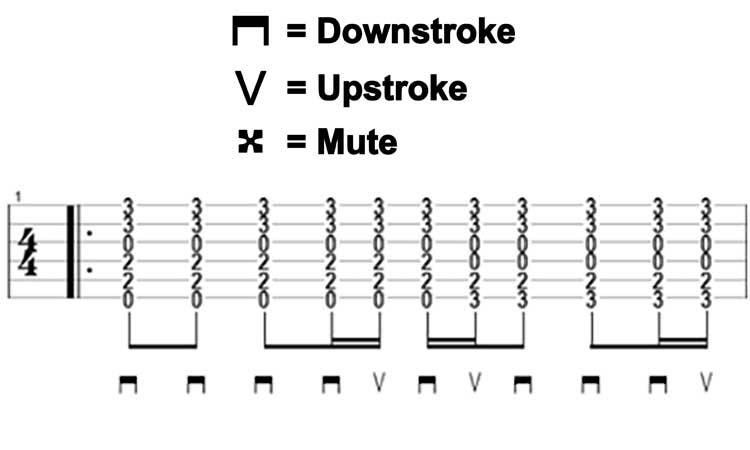When it comes to playing the guitar, one cannot underestimate the vital role of strumming. It is the heartbeat that infuses life into every chord, melody, and song. For newer guitar players eager to embark on their guitar journey, understanding how to strum on guitar is paramount.
In this comprehensive guitar lesson, we will provide you with a solid foundation in strumming, catering specifically to beginner guitarists. We’ll be covering the basics, technique, common problems (with solutions), and finally answer some commonly asked questions.
So grab your guitar, let your fingers find the strings, get ready to unlock the power of strumming!

Understanding The Basics of Strumming
Strumming is an essential technique in guitar playing that involves sweeping or brushing any of the six strings with a pick or fingers. It forms the rhythmic backbone of music, dictating the flow, energy, and dynamics of a song. From accompanying vocals to driving a powerful chord progression, strumming adds depth and character to the guitar’s sound, making it a fundamental skill for any aspiring guitarist.
When it comes to holding the guitar correctly for strumming, it’s crucial to feel comfortable playing. Here are the basics to keep in mind:
Sit up straight with the guitar resting on your thigh, ensuring stability and balance.
Position the lower curve of the guitar’s body against your stomach or torso, allowing for better control and reach.
Tilt the guitar neck slightly upward, creating a natural angle for your fretting hand to access the strings and frets.
Use your strumming hand to lightly rest on the strings near the soundhole, providing stability and control while allowing for fluid strumming motions.
As far as holding the pick & hand positioning, here’s a few basics to follow:
Hold the pick between your thumb and index finger: Position the pick between the side of your thumb and the pad of your index finger. Keep a firm but relaxed grip on the pick.
Angle the pick: Use the pick angled downward slightly, pointing it towards the strings at around a 45-degree angle. This allows for smoother contact with any of the six strings during strumming.
Position your strumming hand: Rest the base of your hand, near the wrist, on the bridge or just above it. This provides stability and control while allowing your hand to move freely during strumming.
Relax your strumming hand: Keep your strumming arm & hand relaxed. Avoid tension and allow for fluid movements. This will help you maintain a consistent rhythm and prevent fatigue.
Remember, hand positioning & preferred grip may vary slightly depending on personal preference and playing style. Experiment and find what feels most comfortable and natural for you, as this will contribute to better strumming technique and overall guitar playing.

How To Strum On Guitar Properly
Downstrokes
A downstroke refers to the motion of strumming the strings by moving your picking hand in a downward direction. During a downstroke, the pick makes contact with the strings as you move from the top strings towards the bottom strings.
Downstrokes are commonly used to establish the foundational rhythm & emphasize the beat in various styles of guitar playing. Here are some things to keep in mind:
Proper Wrist Movement
To execute downstrokes effectively, focus on maintaining a loose and relaxed wrist. Allow your elbow and wrist to hinge naturally as you bring your hand down towards the strings. This wrist movement provides flexibility and control, enabling you to strike the strings smoothly and effortlessly.
Striking the strings evenly
Strumming evenly across the all the strings is crucial for a balanced sound. Aim to strike the strings with consistent pressure and avoid hitting any particular string more forcefully than the others. Practice maintaining a steady motion across the strings, ensuring that each string receives equal attention and volume.
Recommended tempo for practicing downstrokes
When practicing downstrokes, it’s important to start at a comfortable tempo that allows for accuracy and control. Begin with a slower tempo and gradually increase the speed as you feel more confident. It’s better to focus on precision and cleanliness of each downstroke rather than speed alone. Once you have mastered the technique at a slower tempo, you can gradually work your way up to faster tempos.
Upstrokes
An upstroke refers to the motion of strumming the strings by moving your picking hand or pick in an upward direction. This creates a distinct sound and can add variety and texture to your strumming patterns.
Upstrokes are often used to create accents, emphasize specific beats, or introduce a different rhythmic feel within a song.
Hand position for upstrokes
Proper hand position is crucial for executing clean and precise upstrokes. When playing upstrokes, position your hand with your wrist slightly angled upwards, allowing your fingers or pick to move smoothly from the bottom strings to the top strings. Keep your hand relaxed and maintain a light grip on the pick or steady contact with your fingers, ensuring ease of movement.
Achieving consistent sound quality
Focus on striking the strings with a consistent level of force and maintaining an even volume across all the strings. Pay attention to the angle of the pick or the position of your fingers, ensuring that they glide across the strings smoothly and evenly. Practicing with a metronome can help you develop a steady rhythm and consistent sound quality.
Coordinating upstrokes with downstrokes
Coordinating upstrokes with downstrokes is vital for creating fluid strum patterns. Start by practicing individual upstrokes and downstrokes separately to familiarize yourself with the motion and timing of each. Once you feel comfortable, gradually integrate both upstrokes and downstrokes into strumming patterns, paying attention to the transition between the two. Focus on maintaining a consistent rhythm and fluidity in your strumming motion.
Guitar tab symbols for upstrokes & downstrokes:

Basic Strumming Patterns
Strumming patterns are rhythmic combinations of downstrokes and adding upstrokes that give life and character to your guitar playing. They provide a structured framework for strumming chords in various styles of music. Strum patterns consist of a sequence of accented and unaccented strums that create a rhythmic groove, enhancing the overall feel of the song.
Common patterns for beginners
Down, Up, Down, Up: This pattern is widely used and provides a steady rhythm. It starts with a down stroke on the down beat & an upstroke on the upbeat & continues with this alternating pattern. If presented as 1 & 2 & 3 & 4, every numbered beat receives a downstroke, while every “and” receives an upstroke.
Down, Down, Down, Up: This pattern is straightforward and works well for playing songs with a steady beat. Begin with three consecutive downstrokes on the first, second, and third beats. Then, play an upstroke on the fourth beat. Repeat this pattern to maintain driving rhythm that accentuates every beat & anticipates the following music measure.
Rhythm & Timing Development
Rhythm in music refers to the organization of time, the pattern of durations, accents within a musical composition. It establishes the pulse, groove, and sense of forward movement in a piece of music.
Rhythm encompasses the arrangement of notes AND rests, creating a framework for the overall timing and feel of the music.
When it comes to refining your guitar skills, the metronome is an invaluable tool. It provides you with a consistent and steady beat, serving as a reliable guide for your timing & rhythm.
By practicing with a metronome, you develop discipline, improve accuracy, and build a strong sense of timing.
Additionally, the metronome allows you to gradually increase the tempo, challenging yourself & enhancing your playing abilities over time.
Below is a good video to apply all of the fundamentals we have learned so far:
Adding Dynamics to Your Strumming
Dynamics are the varying levels of volume and intensity that you bring to your performance. They allow you to create contrast and shape the emotional expression of the music.
By understanding and effectively utilizing dynamics, you can add depth, excitement, and nuance to your playing, captivating your audience and bringing the music to life.
Dynamic Strumming Techniques
Accenting certain beats or notes
Experiment with accenting specific beats or notes within your strumming pattern. By playing those beats or notes with slightly more force or emphasis, you can create a sense of emphasis or highlight important musical moments.
Varying strumming intensity
Explore playing with different levels of strumming intensity. This involves adjusting the force and power with which you strike the strings. By varying your strumming intensity, you can add dynamics to your playing, ranging from gentle and soft to strong and powerful.
Incorporating palm muting and percussive strums
Explore the technique of palm muting, where you lightly rest the side of your picking hand against the strings near the bridge. This creates a muted and percussive sound, adding a rhythmic texture to your strumming. Experiment with incorporating these palm-muted strums into your playing to add variety and dynamics to your sound.

Common Strumming Challenges & Solutions
When it comes to guitar strumming, you may encounter a few common challenges. Here’s a couple of challenges & their corresponding solutions to help you overcome them:
Struggling With Rhythm
Maintaining a steady rhythm can be difficult, especially when starting out. To improve your rhythm, practice with a metronome. Start at a slow tempo and gradually increase it as you become more comfortable. Focus on subdividing the beats and counting along with the metronome to develop a strong sense of timing.
Difficulty Transitioning Between Chords
Switching chords smoothly while maintaining the strumming pattern can be challenging. Work on chord changes separately, without strumming, until you can switch between them smoothly.
Then, gradually incorporate the strumming pattern, starting at a slower tempo and gradually increasing the speed. Take it one chord change at a time, and practice transitioning between chords until it becomes natural and effortless.
Difficulty With Strumming Patterns
Learning new strum patterns can be overwhelming. Break them down into smaller segments and practice them slowly and accurately. Focus on the hand and wrist movements involved, ensuring they are fluid and relaxed. Gradually increase the speed as you become more comfortable with the pattern.

Frequently Asked Questions
Is it better to strum with a pick or fingers?
Ultimately, it’s a matter of personal choice and the style of music you prefer. Many guitar players utilize a combination of both pick and finger techniques to explore different sounds and adapt to different musical contexts.
Experiment with both options to discover which feels more comfortable and allows you to achieve your desired playing style.
Here’s a few things to also consider when choosing either:
Using a pick:
Provides a consistent and defined sound.
Offers more precision and control for intricate strum patterns.
Produces a brighter and sharper tone.
Suitable for playing genres like rock, pop, and country.
Using fingers:
Allows for a warmer and softer tone.
Provides more versatility in terms of techniques, such as fingerstyle playing.
Offers a natural and organic feel, particularly for acoustic and folk styles.
Can provide more control and nuance in dynamics.
How do you strum accurately?
To strum accurately, focus on your strumming hand and keep it relaxed. Pay attention to the movement of your wrist, ensuring a fluid motion.
Start by strumming slowly and gradually increase the speed as you gain control. Practice with a metronome to develop a steady sense of timing and align your strums with the beats.
Break down complex patterns into smaller parts and practice them individually before combining them. Utilize audio or video references to listen and watch how the strumming is performed in songs.
With practice, patience, and attention to detail, your strumming accuracy will improve, allowing you to confidently play along with your favorite songs and create your own music.
Do you strum all strings when playing chords?
When playing chords, you typically aim to strum all of the strings for a fuller sound.
However, there are many instances where you might intentionally omit certain strings depending on the chord shape you are playing.

Do we have to use the guitar pick? Can I use my thumb and index finger?
Yes, you can absolutely use your thumb and index finger to strum the guitar instead of a pick. This technique is commonly known as fingerstyle or fingerpicking.
It involves using your thumb to pluck the lower strings (usually the bass notes) and your index (and sometimes middle) finger to pluck the higher strings (usually the melody or accompanying notes).
Where do I strum on an electric guitar?
Unlike an acoustic guitar which has a soundhole that serves as a resonating chamber, the sound of an electric guitar is primarily produced through the pickups.
You generally have 3 positions that you can strum on an electric guitar which will affect the tone slightly. They are: Near the bridge (brighter tone), closer to the fretboard (warmer tone), and finally, somewhere in between (balanced). Try them out & see what you like best!
Related: How to clean your guitar’s fretboard
Do I need to memorize all guitar chords or just the basic chords only?
When starting out on the guitar, it is important to focus on learning the basic chords first. These chords, such as open chords like G, C, D, E, and A, will allow you to play a wide variety of songs.
As you progress, you can gradually expand your chord repertoire to include more complex and less commonly used chords. However, you do not need to learn a certain number of chords to be a good guitarist, just learn enough to express yourself through your playing & continually add a little bit more as you go on.
